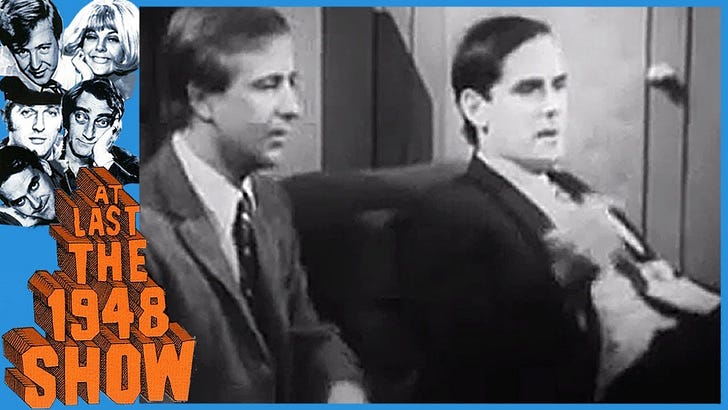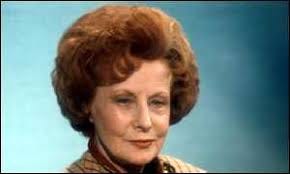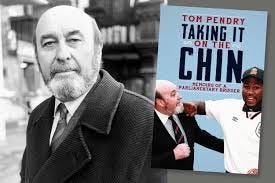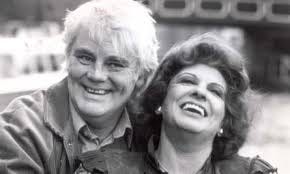Barbara Castle Came to my Wedding
It is not strictly true to say that Barbara Castle came to my wedding.
No photographs exist of my first (ill-fated) wedding at the Register Office in Ashton-under-Lyne, Lancashire. This is fortunate. I would not want 2025 Substack people to see what a horrendous suit this distinguished, debonaire, elegant, elderly gentleman was wearing on that doom-laden day in May 1979. The suit was cream, with a waistcoat that was not happy with my paunch that had given generous financial support to Robinson’s Breweries of Stockport. The jacket was a little tight around the shoulders. (The man in the shop - Take 6 - had remarked, “Sir has very prominent blades.”) The trousers were flared as was de rigueur in those far off days. The brown pointy shoes pinched a little. There was an overall feeling of discomfort and displacement of being out of kilter with the world and my own body and mind.
The only guests were my wife’s children and her mother. Plus Theo, a friend of my wife’s brother. Theo was a very funny man who looked like Chris Evans. Theo had offered to take photographs as well as being, in addition to God, our witness.
After the splicing, the small party repaired to a Chinese restaurant, the name of which now escapes my addled brain, in Hyde, Cheshire. My first wife (and my current one) got annoyed at my excitement on recognising famous people. I am a fool for famous. As soon as we sat down, I noticed that flame-haired siren Barbara Castle was sitting at a nearby table with Tom Pendry, the Labour MP for Stalybridge and Hyde from 1970 to 2001. Pendry won the seat in eight successive general elections. He was unlucky that in those 31 years, 26 of them were in opposition.
At the time, I was working at the DHSS local office in Ashton-under-Lyne. We often got calls from Mrs Pendry, who worked at her husband’s Stalybridge constituency office. Mrs Pendry had been Moira Smith, a Labour councillor in Derby at the same time as Tom. Mrs Pendry was a political force in her own right, not just an adjunct to the masculine one. Moira was the youngest alderman in the country at the age of 26 and became Chair of the Derby Education Committee and later Chair of the whole of Derbyshire Education Committee. She married Tom in 1966. They had two children, Dominic and Fiona. He separated from Moira in 1983 (that date is significant) and she died in 2019.
Blair
Pendry claimed to have persuaded Tony Blair to pursue a political career over lunch in the Gay Hussar, the London restaurant that once served as the Labour party’s networking canteen. Pendry first met Tony Blair through the actor Tony Booth, Pendry’s constituent and father of Blair’s wife, Cherie. I met Booth’s final wife, Steph, (who had once been mayor of Todmorden) at the Daunt bookshop in Marylebone when she invited me to her book launch. I once sat behind Tony Booth and Pat Phoenix at the Library Theatre in Manchester.
Blair disappointed Pendry when Pendry was deemed to be incommensurate with New Labour’s zippy, yoofful image. Pendry had expected to be appointed sports minister but the job was given to Tony Banks (friend of Aimee Mann but not a member of Genesis). Pendry felt harshly done by as in 1995 he had persuaded then Newcastle manager Kevin Keegan to speak at a Labour Party rally on Tyneside which had delighted Blair but not sufficiently to appoint Pendry Minister for Sport, although he then became Chair of the government-funded Football Trust from 1997-99. Pendry was only partly mollified when Blair made him a member of the Privy Council in 2000 and then offered him a seat in the House of Lords after the 2001 general election.
Life of Pendry
Tom was one of five sons born to Leonard Pendry, a lecturer, and his wife Elizabeth, who had been raised in the Labour movement in Durham and sought to pass on her political aspirations to her children. Tom went to Roman Catholic primary schools in Ramsgate, Staffordshire and Tyneside, where he was evacuated during the second world war, and then the former St Augustine’s Abbey school in Ramsgate, where he played football for Kent schools. He joined the Labour party aged 15 and spent two years on national service with the RAF at Cape Collinson camp in Hong Kong. On returning to the UK he studied politics at the Catholic Workers’ College (later known as Plater College) in Oxford, and boxed for Oxford University.
Pendry had spent six years as a Labour whip in the 1970s, three of them in government, and a year as a parliamentary undersecretary in the Northern Ireland Office (as what was known as the “statutory Roman Catholic”) until 1979, As a Catholic, he was a fervent opponent of abortion, which attracted criticism from some of his female MP colleagues.
Celebrities
Pendry’s obituary in The Guardian said he was: “An outgoing, assertive, self-confident politician, Pendry wore brightly coloured shirts with contrasting white collars and loved any sort of public endorsement by celebrity figures.”
One celebrity figure who (allegedly) endorsed Pendry was Aimi McDonald, generally referred to as “The lovely Aimi McDonald.” At Last, the 1948 Show was a forerunner of Monty Python (screened in 1967) . At the opening and closing of the show and between longer sketches, she would present short pieces on the theme of her loveliness. Her excitable, squeaky voice was likened to "a choir of frantic mice".
This clip also features my new Substack chum John Cleese. I have watched a few of these old sketches and find them better than Python. The presence of Marty Feldman is a bonus. The four Yorkshiremen sketch which later became part of the Python live repertoire is here.
Links with Politicians
The lovely Aimi’s Wikipedia profile does not mention Tom Pendry but does say, “Her name was linked to politicians, including Labour Minister John Stonehouse (his secretary and mistress, later wife, Sheila Buckley named her as one of his lovers) and future Conservative Prime Minister John Major. MacDonald has denied relationships with either man, or ever having met ‘poor John Major’.” Stonehouse may have been the inspiration for Reggie Perrin. He is remembered for his unsuccessful attempt at faking his own death in 1974. It is alleged that Stonehouse had been an agent for Czechoslovak military intelligence.
Euston Encounter
In 1982, I got a job with the Social Security Advisory Committee (SSAC), working for the chairman, Sir Arthur Armitage, who was also Vice Chancellor of Manchester University. I moved to rented accommodation in Putney and searched for a house to buy while my wife sold our Manchester house. I would go back to Manchester every other weekend. My wife would come down to London on alternate weekends to veto the prospective homes I had discovered.
This meant that I spent a lot of time loitering around Euston Station on Friday evenings waiting for the Manchester train to come in. One Friday evening in 1983, I was standing at the ticket barrier, when I became aware of a blonde female person of the lovely category standing near me. Being a notorious celebrity watcher, I recognised her from the telly.
I wondered what this lovely person was doing here.
I saw at the far end of the platform the unmistakable bald pate and tonsure of the Right Honourable Member for Stalybridge and Hyde.
I wondered where Moira might be.
When the Honourable Member came through the ticket barrier, the lovely one ran towards him and gave him a big hug. So sweet.
Celebrity Watching in Wimbledon
I found a house in the Wimbledon area. In those days one could not get instant gratification. I had to wait nine months to get a mortgage. In truth, Wife1 hated the south in general and constantly complained that she wanted to go back to Audenshaw.
I was happy with the area, if not with the wife or my job. I met Ronnie Wood a couple of times in my local pub, Ye Olde Leather Bottle. He was very genial. I also saw him and his kids in the betting shop when I was doing my washing in the launderette next door while I was seated next to a transvestite. I used to bump into Bryan Pringle in Threshers and The Dog and Fox near Wimbledon Common. Next door to The Dog and Fox was the Rawalpindi restaurant where I saw Diane Keene getting a takeaway. Hywel Bennett looked somewhat worse for wear when I saw him in another pub beside Wimbledon Common. Edward Judd, of The Day the Earth Caught Fire fame, was often under the same roof as me in local Wimbledon hostelries, particularly The Alexandra. In the film, Judd played an alcoholic and seemed to be playing that role when I saw him up close in real life. According to Val Guest, "he was such a pain in the ass to everybody. He had an enormous opinion of himself and he was his own worst enemy.” He did present a sorry spectacle in 1983.
The mad poet Swinburne used to escape from his carer Watts-Dunton (another Theo) and go to The Rose and Crown near Wimbledon Common (he was an alcoholic and algolagniac who liked to be flogged) but I cannot claim to have met him in the bar. Swinburne wandered off on to Wimbledon Common one day in pouring rain and contracted double pneumonia. He died on 10 April 1909, aged 72 with a smile on his lips. Swinburne looks rather like David Thewlis in this picture.
Someone commented on an article I wrote many years ago that I was like Zelig, a victim of chameleon disorder.
When I asked witness (witless) Theo about the photographs of the wedding, he said, “don’t talk to me about photographs.” Something had gone wrong with his camera. We did not have mobile phones with cameras in 1979. The Registrar who married us was later convicted of fraud. I used to argue, in my jocular way, that this, plus the lack of photographic evidence of the ceremony, was probably grounds for annulment. The marriage ended anyway in 1992, not a day too soon. Having deserted our Wimbledon house, and me, in 1992, she is still occupying the premises.









Thanks for posting this. It’s a warm mix of political trivia and personal memories. All the best!
Yes, so I discovered, but I was referring to the chameleon disorder. Wasn’t sure whether it meant you blended in wherever you were or that you resembled other people.